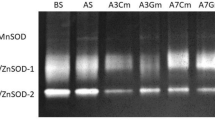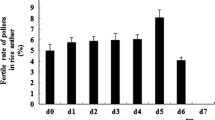Abstract
A cold pretreatment is usually applied to induce maize androgenesis. Peroxidase activity, including indole-3-acetic acid (IAA) oxidase activity, and endogenous IAA concentrations were followed during a cold pretreatment (14 days, 7°C) in anthers of two maize genotypes, Seneca 60 and DH5×DH7, respectively with a low or high androgenetic response. The most prominent result was the absence of a detectable IAA oxidase activity in DH5×DH7. Adding effectors of IAA-oxidase activity or IAA transport did not affect significantly the crude peroxidase activity of DH5×DH7 anthers while inducing a clear inhibition of androgenesis at higher concentrations. No strict correlation was found between IAA level and physiological response, the low responding variety having as much IAA as DH5×DH7. However, for DH5×DH7, every treatment that lowered the IAA level after 14 days of cold resulted in a decrease in androgenetic response.
Similar content being viewed by others
References
Anonymous (1975) Primary study of induction of pollen plant of Zea mays. Acta Genet Sin 2: 138-143
Barloy D, Denis L and Beckert M (1989) Comparison of the aptitude for anther culture in some androgenetic doubled haploid maize lines. Maydica 34: 303-308
Beffa R, Martin HV and Pilet PE (1990) In vitro oxidation of IAA by soluble IAA-oxidases and peroxidases from maize roots. Plant Physiol 94: 485-491
Berthon JY, Maldiney R, Sotta B, Gaspar T and Boyer N (1989) Endogenous levels of plant hormones during the course of adventitious rooting in cuttings of Sequoiadendron giganteum. Biochem Physiol Pflanzen 184: 405-412
Bradford MM (1976) A rapid and sensitive method for the quantitation of microgram quantities of protein utilizing the principle of protein-dye binding. Anal Biochem 72: 248-254
Brunn SA, Muday GK and Haworth P (1992) Auxin transport and the interaction of phytotropins. Probing the properties of a phytotropin binding protein. Plant Physiol 98: 101-107
Coumans MP, Sohota S and Swanson EB (1989) Plant development from isolated microspores of Zea mays L. Plant Cell Rep 7: 618-621
Delalonde M, Barret Y and Coumans MP (1996) Development of phenolic compounds in maize anthers (Zea mays) during cold pretreatment prior to androgenesis. J Plant Physiol 149: 612-616
Delvallée I and Dumas C (1988) Anther development in Zea mays: changes in protein, peroxidase and esterase patterns. J Plant Physiol 132: 210-217
Dieu P and Beckert M (1986) Further studies of androgenetic embryo production and plant regeneration from in vitro cultured anthers in maize (Zea mays L.). Maydica 31: 245-259
Frenkel C and Haard NF (1973) Initiation of ripening in Bartlett pear with an antiauxin ?(p-chlorophenoxy)isobutyric acid. Plant Physiol 52: 380-384
Genovesi AD and Collins GB (1982) In vitro production of haploids plants of corn via anther culture. Crop Sci 22: 1137- 1144
Ku MK, Cheng WC, Kuo LC, Kuan YL, An HP and Huang CH (1978) Induction factors and morpho-cytological characteristics of pollen-derived plants in maize (Zea mays). In: Ku H (ed) Proceedings of Symposium on Plant Tissue Culture, Peking, pp 35-42. London: Pitman Publ Ltd
Label P, Sotta B and Miginiac E (1989) Endogenous levels of abscisic acid and indole-3-acetic acid during in vitro rooting of wild cherry explants produced by micropropagation. Plant Growth Regul 8: 325-333
Miao SH, Kuo CS, Kwei YL, Sun AT, Ku SY, Lu WL, Wang YY, Cheng ML, Wu MK and Hang L (1978) Induction of pollen plants of maize and observation of their progeny. In: Ku H (ed) Proceedings of Symposium on Plant Tissue Culture, Peking, pp 23-33. London: Pitman Publ Ltd
Michalczuk L, Cooke TJ and Cohen JD (1992) Auxin levels at different stages of carrot somatic embryogenesis. Phytochem 31: 1097-1103
Murigneux A, Barloy D, Leroy P and Beckert M(1993) Molecular and morphological evaluation of doubled haploid lines in maize. 1. Homogeneity within DH lines. TAG 86: 837-842
Nitsch C, Andersen S, Godard M, Neuffer MG and Sheridan WF (1982) Production of haploid plants of Zea mays and Pennisetum through androgenesis. In: Earle D and Demarly Y (eds) Variability in Plants regenerated from Tissue Culture. Vol., pp 69-91. New York: Praeger Science
Pace GM, Reed JN, Ho LC and Fahey JW (1987) Anther culture of maize and the visualisation of embryogenic microspores by fluorescent microscopy. TAG 73: 863-869
Petolino JF and Jones AM (1986) Anther culture of elite genotypes of maize. Crop Sci 26: 1072-1074
Protacio CM, Dai Y, Lewis EF and Flores HE (1992) Growth stimulation by catecholamines in plant tissue/organ cultures. Plant Physiol 98: 89-96
Rekoslavskaya NI and Bandurski RS (1994) Indole as a precursor of indole-3-acetic acid in Zea mays. Phytochem 35: 905-909
Rubery PH and Jacobs M (1988) Auxin transport and its regulation by flavonoids. In: Pharis RP and Rood SP (eds) Plant Growth Substances. Vol., pp 428-440. Berlin: Springer Verlag
Singh S, Sawhney VK and Pearce DW (1992) Temperature effects on endogenous indole-3-acetic acid levels in leaves and stamens of the normal and male sterile “stamenless-2” mutant of tomato (Lycopersicon esculentum Mill.). Plant Cell and Environment 15: 373-377
Spena A, Estruch JJ, Prinsen E, Nacken W, Van Onckelen H and Sommer H (1992) Anther-specific expression of the rolB gene of Agrobacterium rhizogenes increases IAA content in anthers and alters anther development and whole flower growth. TAG 84: 520-527
Ting YC, Yu M and Zheng WZ (1981) Improved anther culture of maize (Zea mays L.). Plant Sci Let 23: 139-145
Tsay HS, Miao SH and Widholm JM (1986) Factors affecting haploid plant regeneration from maize anther culture. J Plant Physiol 126: 33-40
Vergne P, Riccardi F, Beckert M and Dumas C (1993) Identification of a 32-kDa anther marker protein for androgenic response in maize, Zea mays L. TAG 86: 843-850
Author information
Authors and Affiliations
Rights and permissions
About this article
Cite this article
Delalonde, M., Coumans, M.P. Effect of IAA content Modulators on peroxidase activity and on endogenous IAA during cold pretreatment of maize anthers prior to androgenesis. Plant Growth Regulation 26, 123–130 (1998). https://doi.org/10.1023/A:1006131620264
Issue Date:
DOI: https://doi.org/10.1023/A:1006131620264




